Phase Matching
Definition: a group of techniques for achieving efficient nonlinear interactions in a medium
More specific terms: critical phase matching, noncritical phase matching, birefringent phase matching, quasi-phase matching, type-I or type-II phase matching, collinear and noncollinear phase matching
German: Phasenanpassung
Categories: nonlinear optics, methods
How to cite the article; suggest additional literature
Author: Dr. Rüdiger Paschotta
Many phase-sensitive nonlinear processes, in particular parametric processes such as frequency doubling, sum and difference frequency generation, parametric amplification and oscillation, and also four-wave mixing, require phase matching to be efficient. Essentially, this means ensuring that a proper phase relationship between the interacting waves (for optimum nonlinear frequency conversion) is maintained along the propagation direction. Only if that condition is fulfilled, amplitude contributions from different locations to the product wave are all in phase at the end of the nonlinear crystal. In other words, some phase mismatch should be close to zero in order to obtain an effective nonlinear interaction. For example, for type I phase matching of frequency doubling with collinear beams the phase mismatch is given by
where k1 and k2 are the wavenumbers of the fundamental and second-harmonic beam, respectively. Without chromatic dispersion, k2 = 2 k1 would hold, so that the phase mismatch vanishes. However, dispersion generally causes a non-zero phase mismatch (Figure 1) if no special measures (as discussed below) are taken to avoid this.

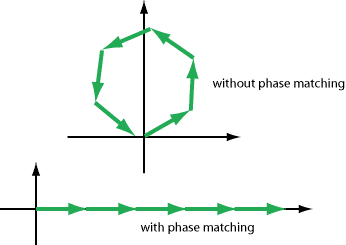
Figure 2 illustrates how a phase mismatch keeps the efficiency low. Here, the arrows illustrate the phasors corresponding to the complex amplitude contributions from different parts of the nonlinear crystal to the harmonic wave. Only when phase matching is achieved, these contributions add up constructively, and a high power conversion efficiency is achieved. Otherwise, the direction of energy transfer changes periodically (possibly thousands of times during the passage through the crystal) according to the change in the phase relation between the interacting waves. The energy then oscillates between the waves rather than being transferred in a constant direction. The effect on the power conversion is illustrated in Figure 3.
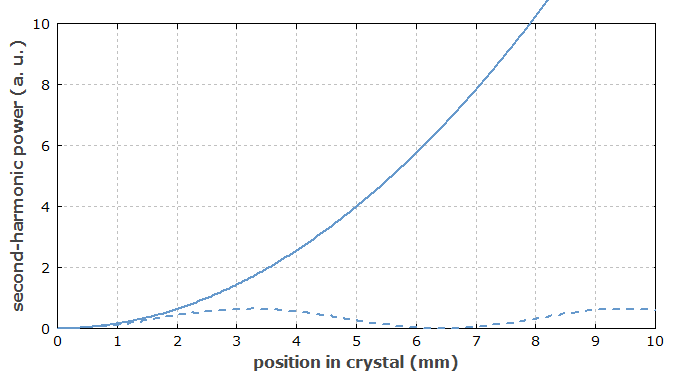
In a frequency doubler, the direction of energy transfer is governed by the complex phase of the term E12 E2*, where E1 is the complex electric field amplitude of the fundamental wave and E2 that of the second harmonic. The asterisk indicates complex conjugation. The phase-matching condition k2 = 2 k1 implies that the phase of the term E12 E2* remains constant along the propagation direction. For a sum frequency generation process, or in a nondegenerate optical parametric oscillator, the corresponding term would be E1 E2 E3*, and the phase-matching condition would be k3 = k1 + k2.
For devices such as frequency doublers or optical parametric amplifiers, phase matching needs to be actively arranged. On the other hand, an optical parametric oscillator may automatically choose its signal wavelength so that phase matching is achieved. Wavelength tuning can thus be achieved by influencing the phase-matching conditions e.g. via temperature changes or angular adjustments.
Phase-matching Curves
When the crystal temperature is varied around the optimum point, the phase mismatch and thus the conversion efficiency also vary, as shown in Figure 4. The temperature range in which a high conversion efficiency is obtained is inversely proportional to the crystal length. It also depends on the temperature dependence of the refractive indices involved. Similar relations apply to other nonlinear frequency conversion processes.
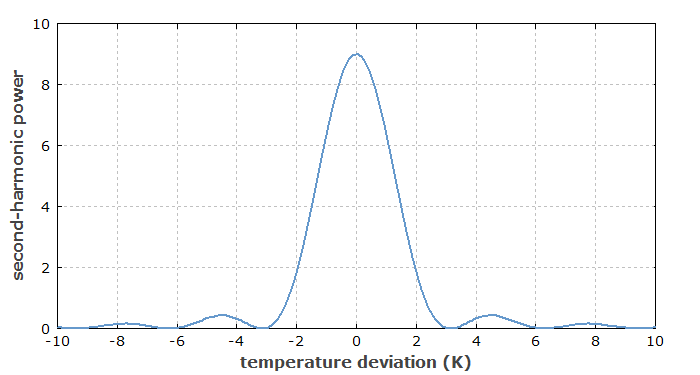
Similar curves are obtained e.g. for critical phase matching when the angular orientation of the crystal is varied.
The phase-matching curve actually does not need to be as symmetric as shown in Figure 4. For example, it becomes asymmetric if the crystal temperature is lower at the crystal end faces, as compared with the middle of the crystal. It is possible to quantify the temperature homogeneity in a crystal oven on the basis of the measured phase-matching curve. Based on such data, it can be estimated whether the conversion efficiency could be increased e.g. by using a longer crystal.
Phase-matching Techniques
The usual technique for achieving phase matching in nonlinear crystals is birefringent phase matching, where one exploits birefringence to cancel the phase mismatch. This technique comes in many variations:
- Type I phase matching means that, e.g., in sum frequency generation the two fundamental beams have the same polarization, perpendicular to that of the sum frequency wave. Conversely, in type II phase matching, the two fundamental beams have different polarization directions; this can be appropriate when the birefringence is relatively strong (overcompensating the dispersion in a type I scheme) and/or the phase velocity mismatch is small. The distinction between type I and type II similarly applies to frequency doubling, and to processes such as degenerate or nondegenerate parametric amplification. The different polarization arrangements can have various practical implications, for example for the combination of several nonlinear conversion stages, or for intracavity frequency doubling.
- Critical phase matching means that an angular adjustment of the crystal (or the beam) is used to find a phase-matching configuration, whereas in noncritical phase matching all polarization directions are along the crystal axes, and the angular position is then not a sensitive parameter.
- The wave vector of all involved beams may have the same direction (collinear phase matching) or different directions (noncollinear phase matching), where, however, the vector sum of the generating beams equals the wave vector of the product beam. A special case is achromatic phase matching where at least one of the interacting beams is angularly dispersed so that each frequency component of the signal is properly phase-matched.
A special technique of significant importance is quasi-phase matching, where real phase matching does not occur, but high conversion efficiencies are nevertheless obtained in a crystal where the sign (or strength) of the nonlinearity varies periodically. Such a periodic variation of nonlinearity can be achieved e.g. by periodic poling. Normally, one then has equal polarization states of all involved waves (as the birefringence is not needed), and this configuration is sometimes called type-0 phase matching.
Phase-matching Bandwidth and Group Velocity Mismatch
When phase matching is achieved, the group velocities of the interacting waves are in general still not matched; there is a certain group velocity mismatch, which limits the interaction length for pulses and (for a given interaction length) the spectral range (called phase-matching bandwidth) in which phase matching is achieved. Also, there is only a finite range of beam angles where phase matching works – particularly for critical phase matching. This range of angles is usually called the angular phase-matching bandwidth. See the article on phase-matching bandwidth for more details.
Choice of Phase-matching Configurations: an Example
For any given crystal and nonlinear interaction (characterized by the participating wavelengths), there may be multiple phase-matching configurations, the comparison of which involves a number of important properties. Which configuration is most suitable, can depend strongly on the application.
An example is sum frequency generation in an LBO crystal, where two inputs are 1064 and 1535 nm generate a red output at 628 nm. For this interaction, there exist three critical and two noncritical phase-matching schemes, considering only collinear phase matching. Also, the cases with critical phase matching are restricted to a crystal temperature of 20 °C. These schemes are listed in Table 1.
Table 1: Various phase-matching schemes for sum frequency generation in LBO.
| Scheme | nonlinearity | walk-off | GVM |
|---|---|---|---|
| XZ I(ee-o), θ = 88.0° | 0.85 pm/V | ρ1 = −1.73 mrad ρ2 = −1.82 mrad |
GVM13 = −0.30 fs/mm GVM23 = +6.0 fs/mm |
| XZ II(eo-e), θ = 19.4° | 0.50 pm/V | ρ1 = −15.1 mrad ρ2 = −16.3 mrad |
GVM13 = +50.4 fs/mm GVM23 = −30.3 fs/mm |
| YZ II(eo-o), θ = 41.1° | 0.51 pm/V | ρ1 = −9.27 mrad | GVM13 = −74.6 fs/mm GVM23 = +51.9 fs/mm |
| X / ZZY at 13.6 °C | 0.85 pm/V | – | GVM13 = −0.29 fs/mm GVM23 = +6.0 fs/mm |
| Z / XYX at 250 °C | 0.67 pm/V | – | GVM13 = +50.4 fs/mm GVM23 = −29.5 fs/mm |
As an example of the nomenclature, the critical scheme XZ I(ee-o), θ = 88.0° means that the beams propagate in the XZ plane with an angle of 88.0° to the Z axis. Both inputs have extraordinary (e) polarization (type I), whereas the product wave has ordinary (o) polarization. As an example of a noncritical scheme of type II, take Z / XYX, where the beams propagate in the Z direction and are polarized in the X (1535 nm), Y (1064 nm), and X (628 nm) directions.
It is important to realize that the choice of phase-matching configuration also influences the effective strength of the nonlinearity, because it determines the directions of the electric fields involved with respect to the crystal axes. There are configurations which would offer, e.g., a large gain bandwidth but are hardly usable since the effective nonlinearity would be very weak.
In principle, the noncritical scheme X / ZZY should offer the best performance, having the highest nonlinearity and no spatial walk-off. However, the critical scheme XZ I(ee-o) is actually very similar: starting from the noncritical scheme X / ZZY, one just rotates the crystal by 2° in order to get phase matching at 20 °C instead of 13.6 °C. The walk-off is very weak, as the beam direction is close to the X axis direction.
In the case that a type II scheme is required (e.g. when the input beams are already collinear but have orthogonal polarization directions), the scheme YZ II(eo-o) might be considered, even though the lower group velocity mismatch of scheme XZ II(eo-e) could be slightly more advantageous for ultrashort pulses, because the dispersive pulse broadening is reduced.
The group velocity mismatch (GVM) e.g. between some pump and signal waves can be important for the conversion of ultrashort pulses, as is related to the phase-matching bandwidth. Note that the GVM values vary considerably between different schemes, demonstrating that the choice of the material alone does not determine how important this issue is. For each particular phase-matching scheme, the optimum crystal length (particularly for ultrashort pulses) and beam waist need to be found.
Obviously, it is very useful to have software which can systematically identify all possible phase-matching configurations for a given nonlinear interaction, based on, e.g., Sellmeier equations for the refractive indices of all involved waves. On this basis, the most suitable scheme can be selected, taking into account the specific requirements for the conversion device to be designed.
Various Remarks
Note that phase matching is in some cases further complicated by the Kerr effect: the resulting intensity-dependent refractive indices also make the phase-matching relations intensity-dependent, and this effect is sometimes significant, e.g. for four-wave mixing processes in fibers.
Phase matching is relevant not only for χ(2) nonlinearities of nonlinear crystal materials, but also for other nonlinear processes. For example, χ(3)-based nonlinear interactions in fibers (e.g. parametric amplification or four-wave mixing) can be phase matched under certain conditions. Such issues are also of great importance in the context of supercontinuum generation. Some nonlinear processes are automatically phase-matched; an example is self-phase modulation, where all photons involved have the same wavelength.
Questions and Comments from Users
Here you can submit questions and comments. As far as they get accepted by the author, they will appear above this paragraph together with the author’s answer. The author will decide on acceptance based on certain criteria. Essentially, the issue must be of sufficiently broad interest.
Please do not enter personal data here; we would otherwise delete it soon. (See also our privacy declaration.) If you wish to receive personal feedback or consultancy from the author, please contact him e.g. via e-mail.
By submitting the information, you give your consent to the potential publication of your inputs on our website according to our rules. (If you later retract your consent, we will delete those inputs.) As your inputs are first reviewed by the author, they may be published with some delay.
Bibliography
| [1] | P. D. Maker et al., “Effects of dispersion and focusing on the production of optical harmonics”, Phys. Rev. Lett. 8 (1), 21 (1962), doi:10.1103/PhysRevLett.8.21 |
| [2] | M. V. Hobden, “Phase-matched second harmonic generation in biaxial crystals”, J. Appl. Phys. 38 (11), 4365 (1967), doi:10.1063/1.1709130 |
| [3] | R. Eckhardt and J. Reintjes, “Phase matching limitations of high efficiency second harmonic generation”, IEEE J. Quantum Electron. 20 (10), 1178 (1984), doi:10.1109/JQE.1984.1072294 |
| [4] | A. V. Smith et al., “Increased acceptance bandwidths in optical frequency conversion by use of multiple walk-off-compensating nonlinear crystals”, J. Opt. Soc. Am. B 15 (1), 122 (1998), doi:10.1364/JOSAB.15.000122; see also references therein |
| [5] | A. M. Schober et al., “Broadband quasi-phase-matched second-harmonic generation of ultrashort optical pulses with spectral angular dispersion”, J. Opt. Soc. Am. B 22 (8), 1699 (2005), doi:10.1364/JOSAB.22.001699 |
| [6] | O. Isaienko and E. Borguet, “Generation of ultra-broadband pulses in the near-IR by non-collinear optical parametric amplification in potassium titanyl phosphate”, Opt. Express 16 (6), 3949 (2008), doi:10.1364/OE.16.003949 |
See also: phase-matching bandwidth, birefringent phase matching, critical phase matching, noncritical phase matching, quasi-phase matching, nonlinear frequency conversion, parametric amplification, nonlinear crystal materials, The Photonics Spotlight 2007-11-19, The Photonics Spotlight 2008-03-10
and other articles in the categories nonlinear optics, methods

This encyclopedia is authored by Dr. Rüdiger Paschotta, the founder and executive of RP Photonics Consulting GmbH. How about a tailored training course from this distinguished expert at your location? Contact RP Photonics to find out how his technical consulting services (e.g. product designs, problem solving, independent evaluations, training) and software could become very valuable for your business!
 |




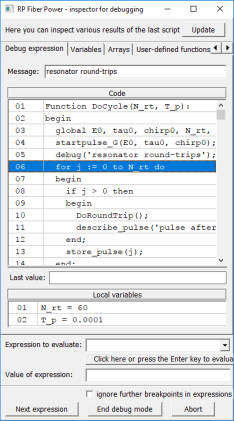


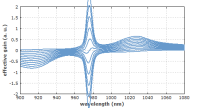
If you like this page, please share the link with your friends and colleagues, e.g. via social media:
These sharing buttons are implemented in a privacy-friendly way!